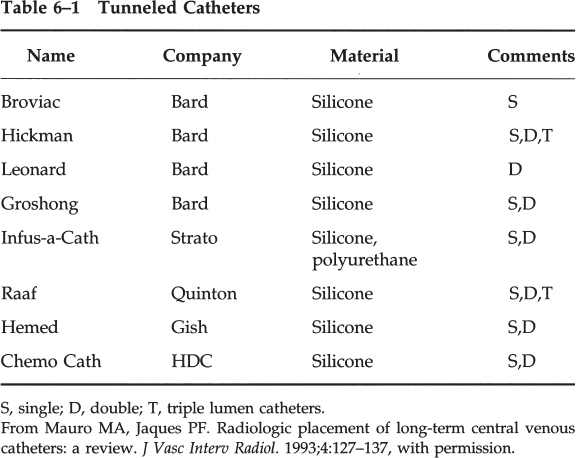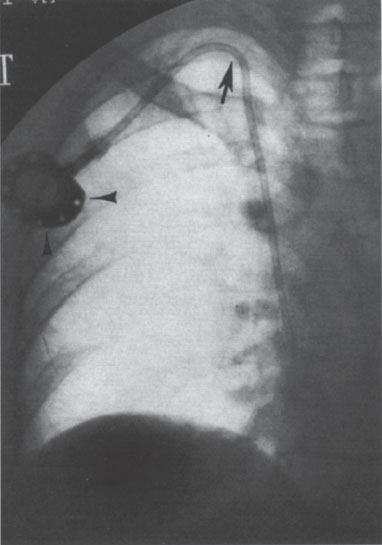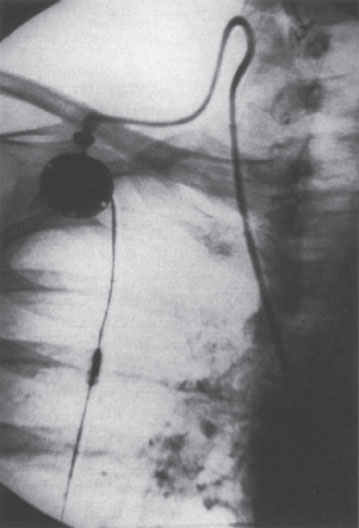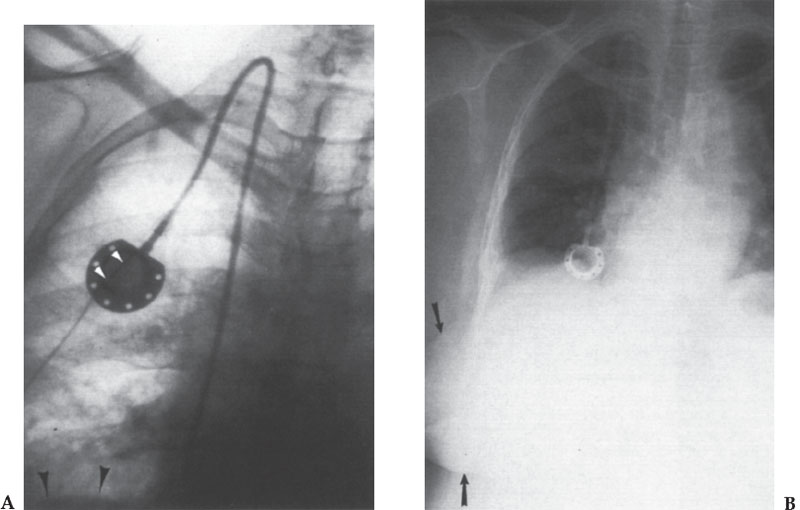Chapter 6
Tunneled Catheters and Chest Ports
DETAILED DESCRIPTION OF OPTIONS
About 400,000 long-term central venous access catheters are placed annually in the United States. These catheters include tunneled right atrial catheters and subcutaneous ports. Originally, these catheters were placed in the operating room and more recently in the radiology suite.1–6 Major concerns regarding their placement are: (1) selecting a suitable access site, (2) avoiding complications of placement, (3) obtaining satisfactory final catheter position, and (4) preventing infection.1–9 This chapter describes placement technique and problems, delayed complications of central catheters and their treatment, and results of radiologic placement.
Catheter Selection
Catheter selection is based on: (1) patient needs (including comfort and ability to care for the catheter), (2) catheter function, and (3) cost.
Patient Needs
Choosing a long-term central catheter requires familiarity with the devices available and their relative advantages and disadvantages. Patient comfort and ability to care for a catheter are important considerations in choosing a catheter. Both debilitated and active patients are good candidates for subcutaneous port catheters. These ports require minimal maintenance and are less likely to interfere with daily activities when not in use. Tunneled external catheters are best for patients requiring large double- and triple-lumen catheters if they are able to care for them. Some properties of catheters are described in the following sections.
Catheter Function
Tunneled Catheters
These catheters are suited for intermediate (i.e., less than 6 months) and long (i.e., more than 6 months) duration access because of their ease of placement and atraumatic access. The external catheters are ideal for multiple and repetitive access and have an advantage over ports in these patients. An example is patients undergoing bone marrow transplant. These patients need frequent access and are often thrombocytopenic. External catheters are without the risk for port pocket bleeding due to thrombocytopenia.10
Peripherally Inserted Central Catheter Lines
Peripherally inserted central catheter (PICC) lines can be substituted for tunneled catheters and ports in many patients. A PICC line can used for up to 6 to 9 months, and, when placed at the bedside, costs the same as three intravenous (IV) placements (John Cardella, personal communication). Any patient expected to have more than three IV catheters during a hospitalization or home treatment is a candidate for a PICC line. One advantage of the PICC line is decreased risk of placement complications of pneumothorax. Subclavian access frequently causes thrombosis or stenosis of the subclavian vein. PICC lines may reduce these complications.
Subcutaneous Ports
Patients requiring less frequent use of their access device for a long term (i.e., more than 6 months) are candidates for subcutaneous ports. Subcutaneous ports are more difficult to place because of the need to create a subcutaneous pocket for the injection port. The ports come in a variety of sizes and configurations, including dual-lumen ports and small ports that are placed in the arm.11 External catheters need to be flushed as often as once a day and have dressing changes every 3 days. Subcutaneous ports need to be flushed only once a month, and dressing changes are not required after the first week post placement. Patients who are unable to care for an external catheter are candidates for subcutaneous ports because of the minimal maintenance that is required. Active patients are also candidates for ports because they do not interfere with daily activities, such as exercise, bathing, and swimming.
Several studies suggest that ports have lower infection rates compared with external catheters.12–19 Other studies16,20 and the only prospective randomized study in the literature,21 however, have shown no significant difference in infection rates between ports and catheters. There are no conclusive data showing a lower infection rate with subcutaneous ports at this time.
Cost and Maintenance
The overall cost of long-term central venous access is time dependent. The purchase price and placement-related costs of ports are higher than external catheters. Ports cost twice the price of an external catheter. On the other hand, the quantity of maintenance supplies required for external catheters is greater than that for ports. Overall, the cost of maintaining a port is less than that of an external catheter, with the break-even point in terms of cost occurring at 6 months.15,22
Low-maintenance cost has been reported with the Groshong catheter (Bard Access, Cranston, RI, U.S.A.) relative to other tunneled right atrial catheters.1,5 The Groshong catheter has a slit valve at its tip and needs to be flushed only once a week with saline as opposed to daily flushes with heparinized saline for nonvalve tip catheters. The decreased need for flushing reduces maintenance cost and is more convenient for patients.1 A recent study showed that these cost benefits are overshadowed by costly problems with line dysfunction.23
DESCRIPTION OF CATHETERS
Tunneled Catheters
The tunneled catheters are made of silicone or polyurethane; vary in length from 36 to 55 cm; have one, two, or three lumens; and range in diameter from 7 to 16 French. These catheters are designed to be placed in a central vein, with their tip in the distal superior vena cava (SVC) or proximal right atrium (RA). Most catheters have an openended tip, although some, like a Groshong, have a valve at their tip to prevent reflux of blood into the catheter lumen. Some commonly used catheters are listed in Table 6–1.
Several centimeters of catheter are tunneled beneath the dermis. The catheters usually have a Dacron cuff and often an antimicrobial cuff. The Dacron cuff secures the catheter in place after 5 to 10 days by fibrosis. The antimicrobial cuff is impregnated with silver chloride. The cuff is positioned near the exit site to act as a barrier to organisms extending centrally to the subcutaneous tunnel or vein. The catheters all have luer lock-type connections for use with syringes and intravenous tubing.
Ports
Ports have reservoirs of different materials attached to silicone or polyurethane catheters (Fig. 6–1). Similar to the tunneled catheters, the tip is placed in the distal SVC or proximal RA. Ports support single- or dual-lumen catheters. Most catheters have a single lumen with an open end hole, although a valve-tip Groshong-type catheter is available. The subcutaneous reservoirs are made of plastic or metal (usually titanium). The upper surface is silicone that can be punctured repeatedly without significant loss of integrity. The ports are generally round with a flat bottom that can be sutured to underling tissues. Table 6–2 lists some common ports, their features, and their manufacturers.


Figure 6–1 Port-A-Cath. The reservoir (arrowheads) is attached to a silicone catheter, which is tunneled subcutaneously and enters the vein(arrow). The port is implanted beneath the skin and can be accessed with a special noncoring needle.
PLACEMENT TECHNIQUES
Placement of central venous access catheters can be broken into three basic steps: preprocedure imaging, obtaining vascular access, and catheter placement.
Preprocedure Imaging
To begin, it is important to review recent chest films for local chest-wall disease or possible mediastinal disease that could affect catheter placement. The patient is placed supine, flat on the angiography table. Trendelenberg may be the ideal position; however, most angiography tables do not tilt to provide this position. The veins typically targeted for access are the subclavian, internal jugular, and cephalic. Ultrasound, with 7- or 5-MHz linear array transducer, of the infraclavicular fossa and neck is performed to evaluate the target vein, looking for altered anatomy or thrombosis. Venography can be useful to define the anatomy further when the ultrasound is abnormal, but it is rarely necessary. Translumbar and transhepatic access to the inferior vena cava is an option in cases where upper-extremity access and femoral access are not possible.24
Table 6–2 Chest Ports
Name | Company | Material |
|---|---|---|
A-Port | Therex | Ti |
Chemo-Port | HDC | SS, silicone |
Hickman | Bard | Plastic, Ti, silicone |
Infuse-A-Port | Strato | Plastic |
Life Port | Strato | Ti, silicone, polyurethane |
Medtronic | Medtronic | Ti, silicone |
Norport | Norfolk | SS, silicone |
Port-A-Cath | Pharmacia Deltec | Ti, silicone |
Q-Port | Quinton | |
SEA Port | Harbor Medical | Silicone |
Vasport | Gish | Ti |
SS, stainless steel; Ti,
Vascular Access
Patient Preparation
Prophylactic antibiotics (1 g of IV cefazolin) were given routinely during the procedure early in our experience, but this practice has been found to be unnecessary.19,25 Midazolam and fentanyl are used for sedation and analgesia. Standard aseptic techniques used in the radiology suite include the wearing of caps, masks, gowns, and sterile gloves; a 5-minute hand scrub by the implanting radiologist; and preprocedure room cleaning with Vesphene IIse (Vestal Laboratories, Inc., St. Louis, MO).
To obtain suitable vascular access, it is important to study all the information available to choose an access site. A brief examination of the patient and a review of any available imaging studies (chest radiograph, chest computed tomography, or venography) should be done to look for potential problems that could be avoided. Some situations include mastectomy, mediastinal masses, and thrombosed veins; then the intended access vein should be evaluated directly using ultrasound or venography.
Once a patent access vein has been identified, the skin is widely prepared with Betadine, and the field is sterilely draped. The skin is anesthetized with 1% lidocaine (with or without epinephrine), and a small incision is made. Using real-time ultrasound or fluoroscopic guidance, a micropuncture needle is advanced into the vein. Ultrasound guidance is preferred because it does not require IV access or IV contrast material and is suitable for jugular, subclavian, and cephalic vein access.
Real-time ultrasound guidance of the access needle can be obtained in the longitudinal or transverse plane.11,24,26 Using the longitudinal approach, the vein and needle path can be observed simultaneously and continually. Problems may arise from not keeping the needle in the plane of the transducer and the ultrasound beam. Using the transverse scanning approach, it is sometimes difficult to keep track of the depth of the needle tip. When scanning in the transverse plane, however, the artery and vein can be observed simultaneously to ensure a venous puncture. Many ultrasound units have a needle guide to control the needle path.
In axillary/subclavian vein access, longitudinal ultrasound guidance is the best choice for access. It is important to know the depth of the needle to prevent inadvertently entering the chest cavity and causing a pneumothorax. The upper chest lends itself to longitudinal positioning of the ultrasound transducer. In addition, longitudinal ultrasound guidance promotes a more lateral approach to the axillary/subclavian vein, which prevents the “pinch-off” syndrome (see later discussion).
When using the internal jugular and external jugular vein for tunneled catheters or ports, it is helpful to access the vein just cephalad to the clavicle for two reasons. First, it is difficult to create a tunnel from the chest to the midneck or vice versa. Second, access close to the clavicle results in a gentle curve of the catheter that prevents kinking (Figs. 6–1 and 6–2). Achieving access close to the clavicle with longitudinal ultrasound guidance is difficult because the length and, to a lesser extent, the width of most transducers puts the needle several centimeters above the clavicle. Whether using the longitudinal or transverse approach, it is often helpful to place the ultrasound transducer cephalad to the access site and needle so that the transducer does not push the needle above the clavicle. Fortunately, the jugular veins are relatively superficial and easy to access with ultrasound guidance.

Figure 6–2 High jugular puncture. Puncture of the jugular vein too high in the neck can result in catheter kinking because of the acute angle necessary to enter the vein. Contrast this to the angle created by a low puncture (Fig. 6.1). Poor positioning of the port within the subcutaneous pocket, too close to the clavicle, could result in the device rubbing against the clavicle, causing irritation and pain.
Catheter Placement
Tunneled Catheters
Venous access always is obtained first because this is the essential step in the process. The order of intravascular placement and subcutaneous tunneling depend on the catheter type. The Groshong catheter is placed through a peel-away sheath into the SVC and tunneled subcutaneously as previously described.1,6 A similar approach is used for the Hickman catheter except this catheter is tunneled first and then it is placed intravascularly.
When making the subcutaneous tunnel, the tunneling device is introduced into the subcutaneous space through a small dermatotomy and passed through the subcutaneous fat, bluntly dissecting a tract to the access site. The catheter then is attached to the tunneler and pulled through the tunnel. Do not attach the catheter prior to tunneling because the force of gripping and pushing the tunneling device can damage the catheter tip at the attachment to the tunneling device.
HELPFUL HINTS
Blunt plastic tunneling devices usually are used to tunnel from the dermatotomy (skin exit site) to the venous puncture site. Stiff metal tunneling devices are intended to be used in the opposite direction, from venous puncture site to skin exit site, and a dermototomy need not be made in advance. The sharp point can be pushed through the skin at the desired exit site.
The access site is closed with absorbable suture (4-0 Vicryl), nonabsorbable material (3-0 Dermalon), or Steri-strips (Shur-strip, Shur Medical Corp., Beaverton, OR). We prefer to close the access site with absorbable suture because it involves less bleeding and follow-up care. The exit site is sterilely dressed using a small 2 × 2-inch gauze.
The external portion of the catheter can be secured in several ways. Most catheter kits come with anchoring devices that can be sutured to the skin. Patients often have difficulty cleaning around the anchoring devices that trap blood and debris beneath them. The catheters can be sutured directly to the skin using half-hitches. Another approach is to tape a safety loop to the chest until the Dacron cuff scars into place. A completion chest radiograph or fluoroscopic image is performed to document position and to evaluate for pneumothorax or other complications.
Pocket Creation and Port Placement
Once venous access is obtained, a subcutaneous pocket for placement of the port is created. The pocket for chest ports is planned over the anterior chest wall, in an area with bony support, away from breast tissue and radiation ports, and with adequate thickness of subcutaneous tissue to cover the port (at least 0.5 cm). Also, the port must be positioned far enough away from the clavicle that it does not rub against this bone (Fig. 6–2). Table 6–3 lists surgical instruments not commonly available in a radiology department that are useful in placing chest ports. A 3- to 5-cm incision is planned just above the proposed port site such that it bisects the perpendicular line from the access site to the center of the port site.
Table 6–3 Useful Instruments for Port Placement
Needle driver |
Rat-tooth pickup |
Army Navy retractor |
Small rake |
Metsembaum scissors |
Suture cutting scissors |
Good overhead light source |
Battery powered cautery (Aaron Medical, St. Petersburg, FL) |
Pacemaker drape |
Lidocaine with epinephrine |
HELPFUL HINT
When making the incision for the port, the incision should be made just large enough for the port to fit barely through. It is best to err on the side of making the incision too small; it can be extended if necessary.
The incision and port site are anesthetized with 1% lidocaine with epinephrine (up to 30 mL). The incision is made with a no. 10 or 15 blade scalpel.
HELPFUL HINTS
Make the incision with the rounded portion of the blade, not with the point. Make the incision in one continuous motion, not in multiple small-connected cuts, which can result in a wound with jagged edges. Cut through the skin and fascia. Part the underlying subcutaneous tissue using blunt dissection.
The pocket is formed by a combination of blunt and sharp dissection until adequate to house the intended port.
HELPFUL HINTS
Perform blunt dissection by pushing a clamp or needle driver into the subcutaneous tissues with the jaws closed and then spread the jaws apart. The finger also can be used to dissect bluntly any residual fibrous strands.
HELPFUL HINTS
Hemostasis can be obtained (if necessary) using electrocautery; however, in most instances, hemostasis can be obtained by tightly packing the pocket with a moist 4 × 4 gauze left in place for 2 to 3 minutes. If pulsatile bleeding is identified from a small skin artery, the site of bleeding must be localized and the bleeder clamped until no more bleeding is seen. A thin (4.0) nonabsorbable suture is tied around the clamp and slid off the tip of the clamp and tightened on the clamped tissue.
The port is sutured to the fascia or muscle with 3-0 Prolene on either side of the port pocket incision. Absorbable suture (3-0 Vicryl) also can be used because the port should be scarred into place before the suture absorbs. After the ends of the suture are lightly clamped, they can be pulled to the side so that they are ready for tying after placing the port in the pocket.
HELPFUL HINTS
Regardless of which suture material is used, the port should be anchored to the tissues to guarantee that the port does not flip within the pocket. The position of the sutures and which port holes the sutures are placed through must be carefully considered so that these sutures do not alter the intended position of the port. That is, a misplaced anchoring suture can cause the port to rotate or displace within the pocket.
The subcutaneous tissue from the venous access site to the midpoint of the pocket is anesthetized with lidocaine. The catheter is tunneled with a tunneling device from the access site to the pocket or vice versa. The tunneling of the catheter from the access site to the port pocket allows the port to be in an ideal location on the chest wall. Ports that are placed in a pocket created as an extension of the access incision often lead to catheter kinking and suboptimal positioning of the port. The catheter is attached to the port, flushed, and trimmed to ideal length. Trimming the catheter to the correct length is hard to estimate. The ideal position of the catheter tip is at the junction of the SVC and RA. The proper length can be measured fluoroscopically using a wire from the access incision. The alternative technique for determining the catheter length is to place the catheter tip at the junction of the SVC and RA. Then the catheter is cut to length and attached to the port. The latter technique is more likely to result in kinking of the catheter in the subcutaneous tissue and therefore is not recommended.
A retractor is useful for visualization of the pocket and for insertion of the port into the pocket. Once the port and catheter are in place, the system should be checked before closing the incisions. A Huber needle is inserted into the port through the skin, and the port is flushed and aspirated. Fluoroscopy can be used to check that the catheter tip is in good position and that there are no kinks. The port should be sutured into the pocket with two anchoring sutures. The catheter is placed in the SVC through a peel-away sheath under fluoroscopic guidance. The best way to avoid air embolism during catheter insertion is to have the patient suspend respiration or hum for the few seconds during catheter placement into the sheath.
After testing the port for flushing and blood aspiration, the pocket is closed in two layers using 2-0 or 4-0 absorbable suture for the deep layer, and 4-0 absorbable suture for the subcuticular layer. The pocket must close without tension being placed on the suture line or the skin over the port. A pocket that is too small or tight can result in pressure necrosis and erosion of the port through the skin. The access site is closed using a single Steri-strip or a subcuticular layer of 4-0 Vicryl. The Huber needle is left in place to use to avoid painful attempts at access into a freshly placed port. The incisions and Huber needle should be dressed sterilely. A completion chest radiography or fluoroscopic image is obtained to document position and to evaluate for pneumothorax. The port is immediately available for use.
COMMON PROBLEMS DURING CATHETER PLACEMENT
Additional problems encountered during placement not discussed in the preceding include catheter malposition, hematoma and bleeding, pneumothorax, and air embolism. It is important to be familiar with these potential complications and their correction.
Catheter Malposition
The ideal position for the catheter tip is in the proximal RA (Fig. 6–1). This position limits thrombosis at the catheter tip, catheter ensheathment with fibrin, and possibly central venous thrombosis. Significant shifts in the catheter tip position occur in subclavian catheters, in obese patients (Fig. 6–3), in women, and when changing from supine to upright position (Fig. 6–4).27 Catheters placed with their tip in the brachiocephalic vein or upper SVC have a 29% rate of thrombotic complications (Figs. 6–5 and 6–6).28 These problems should be avoided when possible.
Occasionally, it will be difficult to advance the catheter through the peel-away sheath. This occurs commonly when using the right subclavian approach because of the short distance between the site of venous access and the acute angle between the right subclavian vein and SVC. There are solutions to this problem. The first is to pull the sheath back proximal to where it is kinked and then advance the catheter. The second is to insert a hydrophilic glidewire through the peel away and advance the catheter over the wire.
Hematomas and Bleeding
Hematomas during catheter placement usually result from inadvertent arterial puncture or from a skin vessel disrupted during tunneling. Manual pressure over the site of bleeding is usually adequate treatment as long as the bleeding is not into the chest cavity. When the axillary, subclavian artery or branch is punctured in the midclavicular line or more lateral, it is easy to apply adequate pressure to the puncture site to achieve homeostasis. This is another advantage of the lateral approach for subclavian access mentioned in the preceding section. In patients with continued bleeding at the access site, exit site, or port pocket, using a cautery device or sutures should be used to achieve hemostasis.
HELPFUL HINTS
When bleeding persists from the skin exit site, it is important to determine whether the bleeding is from the venous puncture or from a vessel in the subcutaneous tunnel. To make this determination, apply pressure to the venous entry site, which should stop bleeding from the internal jugular vein. If bleeding persists, the bleeding is likely from the subcutaneous tunnel, and pressure should be held over the tract.

Figure 6–3 Catheter shift in an obese woman. (A) A completion image with the patient in the supine position shows adequate position of the port and catheter with the catheter tip in the right atrium. The Huber needle is in place (white arrowheads).Diaphragm (black arrowheads). (B) A chest radiograph obtained with the patient in the upright position shows that the abundant soft tissues of the chest wall (black arrows) have dropped, pulling the port caudally and pulling the attached catheter back. The catheter tip now lies in the superior vena cava. Note the distance that the port has migrated away from the clavicle.



